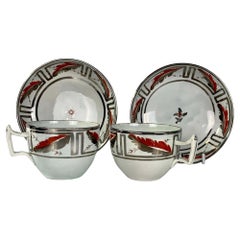Tea Leaf Lustre
Recent Sales
Antique Early 19th Century English Neoclassical Tea Sets
Pearlware
A Close Look at neoclassical Furniture
Neoclassical design emerged in Europe in the 1750s, as the Age of Enlightenment reached full flower. Neoclassical furniture took its cues from the styles of ancient Rome and Athens: symmetrical, ordered, dignified forms with such details as tapered and fluted chair and table legs, backrest finials and scrolled arms.
Over a period of some 20 years, first in France and later in Britain, neoclassical design — also known as Louis XVI, or Louis Seize — would supersede the lithe and curvaceous Rococo or Louis XV style.
The first half of the 18th century had seen a rebirth of interest in classical antiquity. The "Grand Tour" of Europe, codified as a part of the proper education of a patrician gentleman, included an extended visit to Rome. Some ventured further, to sketch the ruins of ancient Greece. These drawings and others — particularly those derived from the surprising and rich archaeological discoveries in the 1730s and ’40s at the sites of the Roman cities of Pompeii and Herculaneum — caused great excitement among intellectuals and aesthetes alike.
Neoclassical furniture is meant to reflect both grace and power. The overall appearance of neoclassical chairs, tables and cabinetry is strong and rectilinear. These pieces are, in effect, classical architecture in miniature: chair and table legs are shaped like columns; cabinets are constructed with elements that mirror friezes and pediments.
Yet neoclassicism is enlivened by gilt and silver leaf, marquetry, and carved and applied ornamental motifs based on Greek and Roman sculpture: acanthus leaves, garlands, laurel wreaths, sheaves of arrow, medallions and chair splats are carved in the shapes of lyres and urns. Ormolu — or elaborate bronze gilding — was essential to French design in the 18th and 19th centuries as a cornerstone of the neoclassical and Empire styles.
As you can see from the furniture on these pages, there is a bit of whimsy in such stately pieces — a touch of lightness that will always keep neoclassicism fresh.
Find antique neoclassical furniture today on 1stDibs.
Finding the Right pottery for You
Even if you’re (understandably) boastful of your minimalist loft apartment or breezy California coastal-style decor, your space could probably still use some streamlined antique and vintage pottery, which can prove both timeless and on-trend.
Pottery, which sees clay and other ceramic materials fired at high temperatures in order to lend them a durable and robust form, can introduce color and character to your dining room or living room. Pottery includes stoneware, porcelain and earthenware and, depending upon a piece’s origins, can vary considerably in style, form and function from one vessel to another. This makes it easy to find pottery for your interiors or outdoor garden areas, regardless of color scheme or design style.
“Ceramics are definitely seeing a resurgence in the decorating and art worlds,” says the team of Mat Sanders and Brandon Quattrone of interior design firm Consort. The personalization of handmade craftsmanship has served as a sort of anti-Internet to screen-weary decorators.
The rustic appearance of some mid-century-era Mexican pottery, such as a jug or water pitcher, can add earthy charm to your breakfast table while hand-painted antique Japanese pottery, such as a planter for your patio, might be characterized by rich colors and exquisitely detailed landscape scenes.
On 1stDibs, find a wide range of antique, new and vintage pottery with origins in countries all over the world. Our collection includes vases, vessels and other tableware from France, Italy and China as well as contemporary pottery and pieces that date from the 18th century and earlier.
